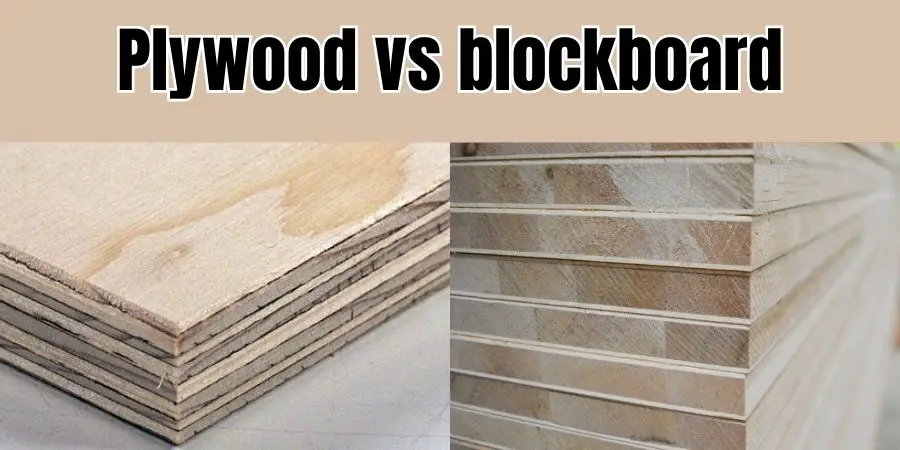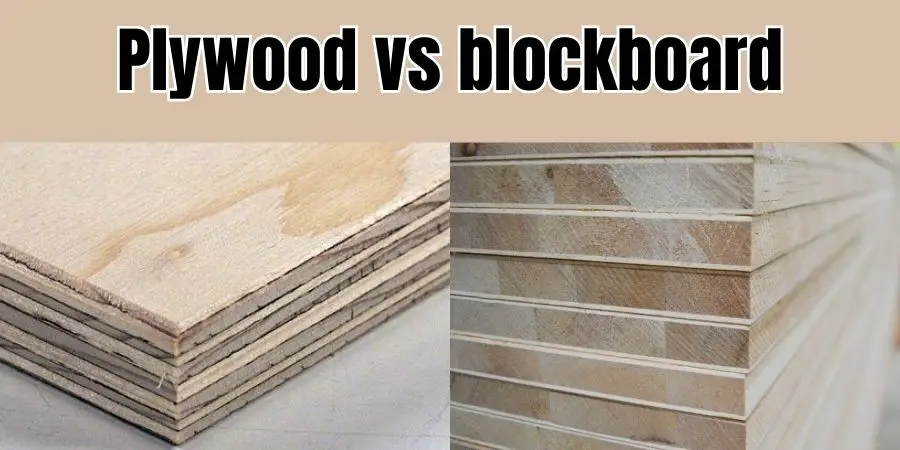The main difference between plywood and blockboard lies in their construction.

Plywood is made of multiple layers of thin wood veneers that are glued together with the grain of each layer running perpendicular to the adjacent layer.
Blockboard is made of a core of softwood strips or blocks that are sandwiched between two layers of veneer or thin wooden boards.
Table of Contents
Difference between Plywood vs Blockboad
Plywood:
This is a strong and durable material that is often used in construction and renovation projects. It’s great for building floors, walls, and roofs, and is also commonly used in the making of cabinetry and furniture. Plywood is also a popular material for DIY projects, such as shelving and storage units.
Blockboard:
This material is lighter and more affordable than plywood, making it ideal for lightweight furniture and decorative purposes. It’s commonly used for making wall paneling, shelving, and other interior decoration items. However, blockboard may not be as strong or stable as plywood, so it’s important to consider the intended use before choosing this material.
Plywood vs Blockboard- pros and cons
Sure, here are the pros and cons of plywood and blockboard:
Plywood Pros
- Strong and durable
- Resistant to warping, cracking, and shrinking
- Available in a range of thicknesses and finishes
- Can be used for heavy-duty applications
- Easy to cut, shape, and join
- Holds screws and nails well
- Offers good insulation and soundproofing properties
Plywood Cons
- More expensive than blockboard
- Heavier than blockboard
- May contain voids or knots that weaken the material
- May split or splinter if cut improperly
Blockboard Pros
- Lighter and more affordable than plywood
- Easier to work with and handle
- Provides a smooth surface finish
- Suitable for decorative applications and lightweight furniture
- Less likely to warp or twist than plywood
- Can be finished with veneers, laminates, or paints
Blockboard Cons
- Less strong and stable than plywood
- Not suitable for heavy-duty applications
- May sag or bend over time
- May contain voids or gaps that weaken the material
- Not as durable as plywood
Is plywood or blockboard better?
Strength and Stability
Plywood is stronger and more stable due to its layered construction, making it better suited for structural or heavy-duty applications.
Blockboard is less strong and stable than plywood, making it better suited for lightweight furniture or decorative applications.
Weight and Cost
Plywood is heavier and more expensive than blockboard, but is also stronger and more durable.
Blockboard is lighter and more affordable than plywood, but may be less suitable for heavy-duty applications.
Specific Uses
Plywood is commonly used for flooring, cabinetry, and construction, while blockboard is often used for lightweight furniture, wall paneling, and shelving.
Blockboard is also ideal for curved surfaces, while blockboard is not as flexible.
Durability and Maintenance
Plywood is more resistant to warping and cracking than blockboard, but may be more prone to visible voids or patches if not made from high-quality materials.
Blockboard may be prone to sagging or bending if not supported properly, but is easier to finish and paint than plywood.
Aesthetics
- Both plywood and blockboard come in a range of finishes, grades, and sizes. Consider the design and aesthetics of your project when choosing which material to use.
In summary, plywood is generally considered the better choice for heavy-duty or structural applications, while blockboard is better suited for lightweight furniture or decorative purposes. However, the specific needs of your project should be considered carefully before making a final decision.
Conclusion- Blockboard vs plywood table
| Property/Use | Plywood | Blockboard |
|---|---|---|
| Construction | Multiple layers of thin wood veneers glued together. | Core of softwood strips or blocks sandwiched between veneers. |
| Strength and Stability | Stronger and more stable. | Less strong and stable. |
| Weight and Cost | Heavier and more expensive. | Lighter and more affordable. |
| Specific Uses | Flooring, cabinetry, and construction. | Lightweight furniture, wall paneling, and shelving. |
| Surface Finish | Range of finishes and grades. | Smoother surface finish. |
| Pros | Strong, durable, easy to work with, good insulation and soundproofing. | Lighter, easier to work with, smoother surface finish. |
| Cons | More expensive, heavier, may contain voids or knots. | Less strong, may sag or bend over time, may contain voids or gaps. |





